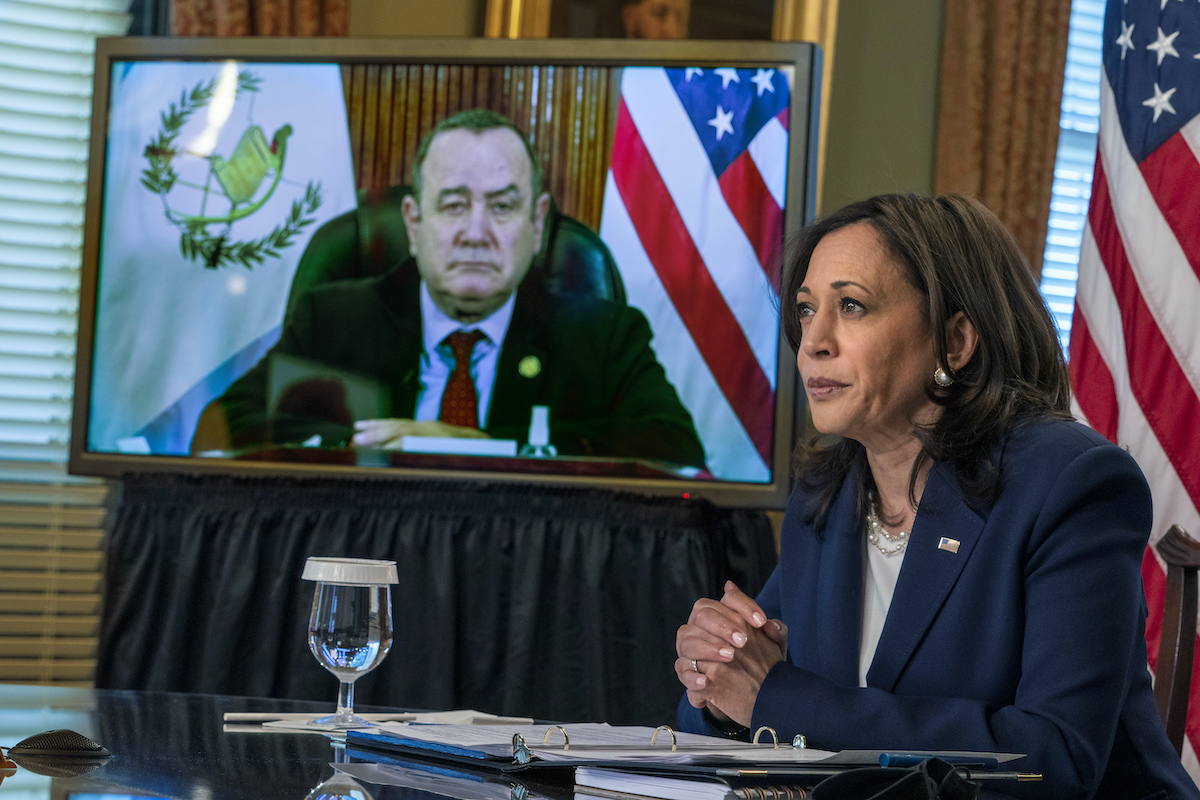

Vice President Kamala Harris meets virtually with Guatemala’s President Alejandro Giammattei, seen on screen at left, Monday, April 26, 2021. (AP Photo/Jacquelyn Martin)
Earlier on Thursday, the White House released a cover message from Vice President Kamala Harris and a report about how the U.S. should be addressing the root causes of migration from Central America. Here is what it shared:
Cover Message From Vice President Kamala Harris
In Central America, the root causes of migration run deep—and migration from the region has a direct impact on the United States. For that reason, our nation must consistently engage with the region to address the hardships that cause people to leave Central America and come to our border.
For decades, our nation has engaged in Central America. Often well-intentioned, the engagement has often not been consistent. And over the last few years, the United States significantly pulled back from work in the region.
Under our Administration, President Joe Biden and I have restarted our nation’s engagement in Central America and diplomatic efforts with Central American governments. Our Root Causes Strategy is comprehensive and draws from decades of experience—and is based on four core pieces of evidence.
First, addressing the root causes of migration is critical to our overall immigration effort.
Just after we took office, President Joe Biden outlined our Administration’s vision to reform our immigration system by creating a pathway to citizenship for the nearly 11 million undocumented migrants in our country, modernizing our immigration process, and effectively managing our border.
Shortly after that, the President asked me to lead our nation’s efforts to address the root causes of that migration. That is because migration to our border is also a symptom of much larger issues in the region.
Second, providing relief is not sufficient to stem migration from the region.
The COVID-19 pandemic and extreme weather conditions have indeed exacerbated the root causes of migration—which include corruption, violence, trafficking, and poverty. While our Administration is proud that we have sent millions of vaccine doses and hurricane relief, we know that it is not enough to alleviate suffering in the long term.
The root causes must be addressed both in addition to relief efforts —and apart from these efforts. In everything we do, we must target our efforts in those areas of highest out-migration— and ensure that these programs meet the highest standards of accountability and effectiveness.
Third, unless we address all of the root causes, problems will persist.
Recently, I traveled to Guatemala, where one of the largest challenges is corruption. Our Administration knows that, where corruption goes unchecked, people suffer. And so, on that trip, the United States announced that we will launch an Anticorruption Task Force which will include U.S. prosecutors and law enforcement experts who will investigate corruption cases. It is our goal that, in dealing directly with corruption, we will also mitigate the lack of economic and educational opportunities on the ground.
Fourth, and most importantly, the United States cannot do this work alone.
Our Strategy is far-reaching—and focuses on our partnerships with other governments, international institutions, businesses, foundations, and civil society. At this writing, we have already received commitments from the governments of Mexico, Japan, and Korea, and the United Nations, to join the United States in providing relief to the region. Our Administration is also working hand-in-hand with foundations and non-profits to accelerate efforts in Central America.
While, in the past, the private sector has been an underutilized partner, our Administration is calling on U.S. and international businesses to invest in the region—and thus far, 12 have done so. Private sector investment not only boosts economic opportunity, but it also incentivizes regional governments to create the conditions on the ground to attract such investment.
Ultimately, our Administration will consistently engage in the region to address the root causes of migration. We will build on what works, and we will pivot away from what does not work. It will not be easy, and progress will not be instantaneous, but we are committed to getting it right. Because we know: The strength and security of the United States depend on the implementation of strategies like this one.


